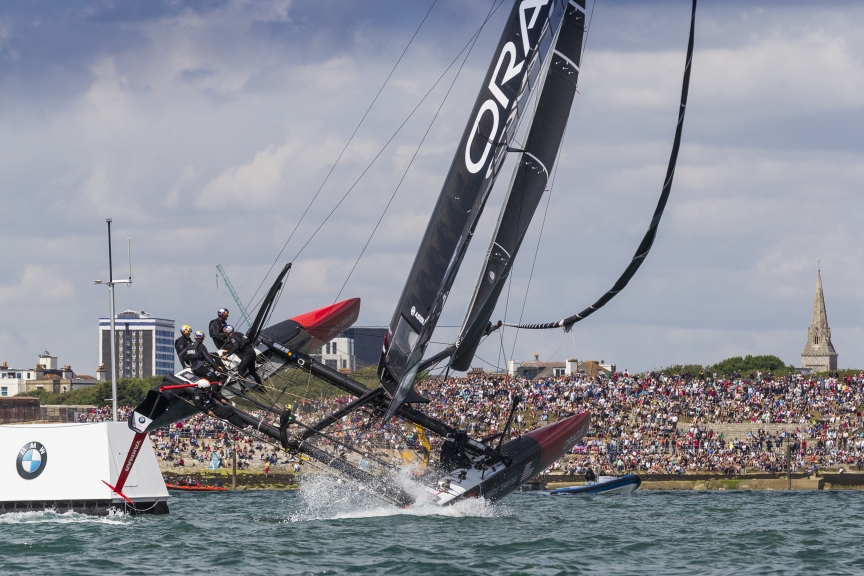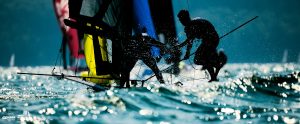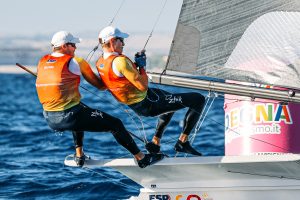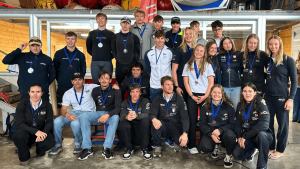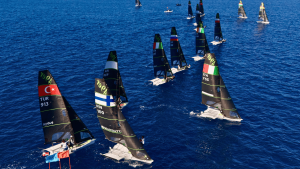The run up to America’s Cup 35 started with a bang as America’s Cup Racing starting in earnest in Portsmouth a full two years ahead of the AC35 in Bermuda. The AC34 Run up had some good events and for those of us that enjoy fleet racing it’s great to see those events continue. While details are a bit thin at times is sounds like there will be two events in Europe this summer, Portsmouth and Gothenberg, followed by Bermuda in October and then six events in 2016. Nine full on ACWS events is a great build up to the big boat event when it comes in 2017.
First things let talk about the highlights from Day 1.
Venue
Hats off to Land Rover BAR for having the wherewithal to turn Portsmouth into a sailing destination for the British public. The Olympic sphere did a great job of getting people out to the Nothe Course in Weymouth for London 2012, but Portsmouth is twice as close to London and an easy day trip for a huge portion of the British public. It has the capability to be the new Wimbledon of sailing. The crowds came out in droves, and to be sure, like most modern sporting events they were probably a bit bored by the action, but equally caught up by the live event atmosphere.
Jyrki Jarvi, the Finish Gold medallist from 2000 who runs the 49er Grand Prix always talks about proximity to a spectators, and how the rewards of being close grow the closer the spectator can get. Sailing has shown a number of times recently that it is possible to draw large crowds. The Nothe course in London, as previously mentioned, San Francisco for AC34, Newport for the Volvo Ocean Race, and now again in Portsmouth. There are masses of people who want to watch the big races. While all of these courses have been close to shore, they still fall into Jyrki’s ‘not really very good’ category, of 500m to 2km distance from the spectator.
At this range, a spectator can see there are things happening, at times they can even start to feel the rush of what’s going on, but most of the time the details are lost and the spectator will have a good time being in a large group but ultimately it is just a novelty that need not be done again once seen. There remains very little that sailing can do to counteract this fact bar going the Extreme Sailing Series route, which really just makes the sailing quite annoying to watch in any case. Still, lots of bodies and most will have had an excellent day out.
As proximity comes down, the enjoyment of watching a sport goes up exponentially. At 50m to 200m many details and nuances can be seen, the speed enjoyed, and noise can be heard. 50m to 10m the thrill of a sport is aparent and the spectator catch watch the game play out, getting into the competition fully. By the time a spectator is within 10m they are practically part of the game and the sweat, blood, teams and curses are part of them. It is difficult to see how a sailing public can get this close to racing without a floating walkway up the course boundary, but at least the public can have a nice day out.
Online Access
The website seems to have done a good job acting as a guide to locals who came to the events, concerts, village, etc., but actual racing coverage is not fantastic. The social media was again average and the best voice during racing was from big Beau of Artemis. Everything drives you to the app, which is well enough laid out if not a bit cluttered compared the elegant app of AC34. Then there was the news of the dreaded pay per view so followers would have to pay for the live racing. Like all sailors, we’re as cheap here as the next place but the app is a good investment. $7 is a fair price for any amount of entertainment, and certainly the live racing qualifies as quality entertainment. Further, sailing fans have to realize that the ACWS is not a requirement for the America’s Cup, and if we want to have good coverage of a reasonable number of events the money must come from somewhere. My own personal experience with the app was it was easy to get, slightly harder to pay for and upgrade to the live so I ended up watching the racing on tape delay, which is still fine. Top tip, make sure to sign into the app after you pay otherwise it will keep you in an endless holding pattern.
The Teams
Contrariety to what might leap out from AC35 its’ the teams is where the biggest strides have been made from AC32 and the old style AC. Gone are the AC lifers, the broad skilled mechanics, plumbers, electricians, sailmakers, sanders, glassers, and riggers who can also sail well who made up the bulk of the sailing teams in the past. There simply is no room for anything but the best on these boats, and while each of the teams has gone about things slightly differently each crew line up is truly compelling.
Oracle has gone for youth and personality, with most of the crew in their 20’s plus huge names at the back in Slingsby and Spithill. Artemis is going for Gold, with four gold medalists out of five sailors on board. The leader, Percy, clearly still has the strength to handle the bow position on the boat as a former star sailor, and though that’s probably counterintuitive to old school sailing where agility on the bow was prized, the bow on a cat does a lot of hoisting of really heavy draggy sails. Being a powerhouse is a must! Who wouldn’t be happy to see Freddy Loof make the team. Many of us saw his humble retreat from keelboat sailing when he showed up at moth events for the past two years, knowing he was starting a whole new type of sailing but putting in his time anyways. It’s clearly paid off and shown that it’s never too late to get into high performance sailing. Then there are the 49er duo of Nath and Goobs on the tiller and mailsheet…. just like normal.
We see the same line-up for Emirates Team New Zealand, with a 49er duo at the back with Burling and Tuke, along with a very experienced boat up front. Then there is the all British squad, proud of queen and country and only too happy to talk about it, with the cream of the British Sailing team on board. At the back is Ben Ainslie, team driver and namesake, but all through the squad are accomplished dinghy and pro sailors, with the huge powerhouse Giles Scott of and former 49er sailors turned versatile pro sailing Paul Campbell James.
The French have a superstar lineup of absolute top professional sailors, and the newest team on the block, Softbank Japan have done a great job hiring managing to pull two huge names in the sport to drive them in Dean Barker and Chris Draper.
All of these teams are chocked full of sailors anyone would agree are the best in the world and equally with plenty of compelling rivalries and back stories.
The Racing and Boats
The fleet racing is pretty darn good. While six boats is slightly too few for pure fleet racing, it’s close enough to the optimum number of 8-12 boats for a live broadcast. It’s closer to optimum than Gold Fleet 49er racing at 25 boats where there are too many boats for a viewer to keep track of and certainly the Sailing World Cup fleets of 40 boats where top sailor get burred unable to great out and have recognisable names racing each other boat on boat. Six is too few as there were times where there were no battles on the water so looses some racing aspect but it’s in the ballpark.
The course is as good as can be hoped for. The reaching starts are a spectacle unequalled in sailing, with the boats foiling alongside each other and heading straight at the cameras and shore. The coverage still hasn’t worked out how to communicate the intensity of a start, but that’s no different to any fleet racing these days. Also, while the reaching starts are a great spectacle there is a good argument for upwindstarts, where more teams can have excellent starts. The drag race to mark one and bear away in AC is intense, but does not last long. There are usually only a couple teams that get the timing right, and then no more than three within 10 seconds, which quickly converts to a leader at mark one, all within 40 seconds. In a great fleet race, every team can come off the line well, then there are the battles at the port and starboard boundary, then there is the battle between port and starboard rights upwind before someone gets around a mark first. Both have their advantages, if the reaching starts can keep more teams in the hunt longer it would great for the viewer.
It will be hard to replicate the amazing pre-starts of keel boat match racing. The upwinds are good enough, but the boats matter little in upwind sailing. Watching lasers, Finns, 49ers, AC boats or otherwise are all pretty much the same to watch upwind. The guys are hiking, which adds a dimension and they are turning winches to show action. The onboard audio is excellent, which helps a ton to communicate the action and the five guys are short handed so are constantly busy.
The downwinds are half amazing and half terrible. At the best, it’s two foiling boats on opposite gybes downwind on a collision course having to foil gybe on top of each other. At it’s worst there are no spinnakers, denying the publish the one easy opportunity to know the difference between upwind and downwind. Most the time the boats will not even use gennakers, opting to just keep their jibs and when they do, ‘deploy’ just does not have the drama of hoist or douse. The tacking angles are all over the place and most of the manoeuvres are just plain ugly to watch on a catamaran. I’ll take a 49er downwind for visual appeal any day.
The coverage was pretty darn good, with plenty of cameras, familiar and knowledgeable voices, great graphics and pretty good racing. Certainly worth the couple cups of coffee the app costs, so enjoy.

